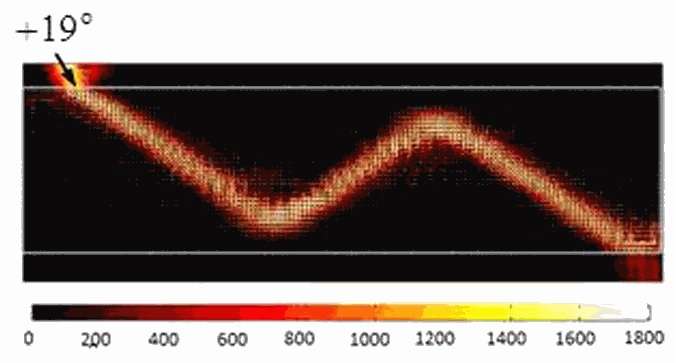A self-collimated one-way light beam can be steered inside a photonic crystal using gradient magnetic fields. Credit: Li, et al. ©2015 AIP Publishing
(Phys.org)—Over the past few years, scientists have demonstrated the phenomenon of "one-way light," in which a light beam propagates in one direction only. The materials used to achieve this effect can be thought of as optical diodes, in analogy to the diodes used in electric circuits that allow an electric current to travel in one direction while prohibiting it from traveling in the opposite direction. One-way light could play an important role in integrated photonic circuits, which perform operations using beams of light instead of an electric current.
Researchers have previously shown that a few different materials, such as photonic crystals and metamaterials, can be used to realize one-way light. These materials typically have some kind of asymmetry that routes light differently depending on which direction the waves are traveling.
Building on this research, Qing-Bo Li, et al., from Nanjing University in China have theoretically shown that one-way light beams in photonic crystals can be bent into arbitrary trajectories by applying a gradient magnetic field. Their work is published in a recent issue of Applied Physics Letters.
Typically, light beams in a photonic crystal broaden as they propagate, which limits their applications. However, here the researchers showed that photonic crystals can be tuned so that the light self-collimates, staying highly focused. Applying a gradient magnetic field to the photonic crystal then causes the self-collimated, one-way beam to gradually change its direction.
"First, we found the novel effect of self-collimation of a unidirectional electromagnetic wave beam in gyrotropic photonic crystals," coauthor Rui-xin Wu at Nanjing University told Phys.org. "Second, the more interesting part is that we can steer the wave beam trajectory through the distribution of a bias magnetic field, providing a flexible means to control the wave beam propagation."
In the future, the researchers plan to further investigate the underlying mechanism, called anisotropic magnetic permeability, that is responsible for this phenomenon.
The ability to steer one-way light beams could have a variety of applications, such as in optical communication, signal processing, and one-way invisibility cloaking.
"We can use the magnetic photonic crystal as an 'electromagnetic diode' with one input and multiple outputs, since the path of the wave beam is determined by the configuration of the bias magnetic field," Wu said. "By dynamically changing the magnetic field configuration, the input wave beam can be tuned to a desired output, which could be useful for wave signal switching and processing, as well as dynamic wave routing.
"Another potential application is to hide an object within the photonic crystal. Since the wave path can be bent in a controlled way, we can have the wave beam trajectory go around but not hit the object, so that the object cannot be seen."
More information: Qing-Bo Li, et al. "Bending self-collimated one-way light by using gyromagnetic photonic crystals." Applied Physics Letters. DOI: 10.1063/1.4938008
Journal information: Applied Physics Letters
© 2016 Phys.org























